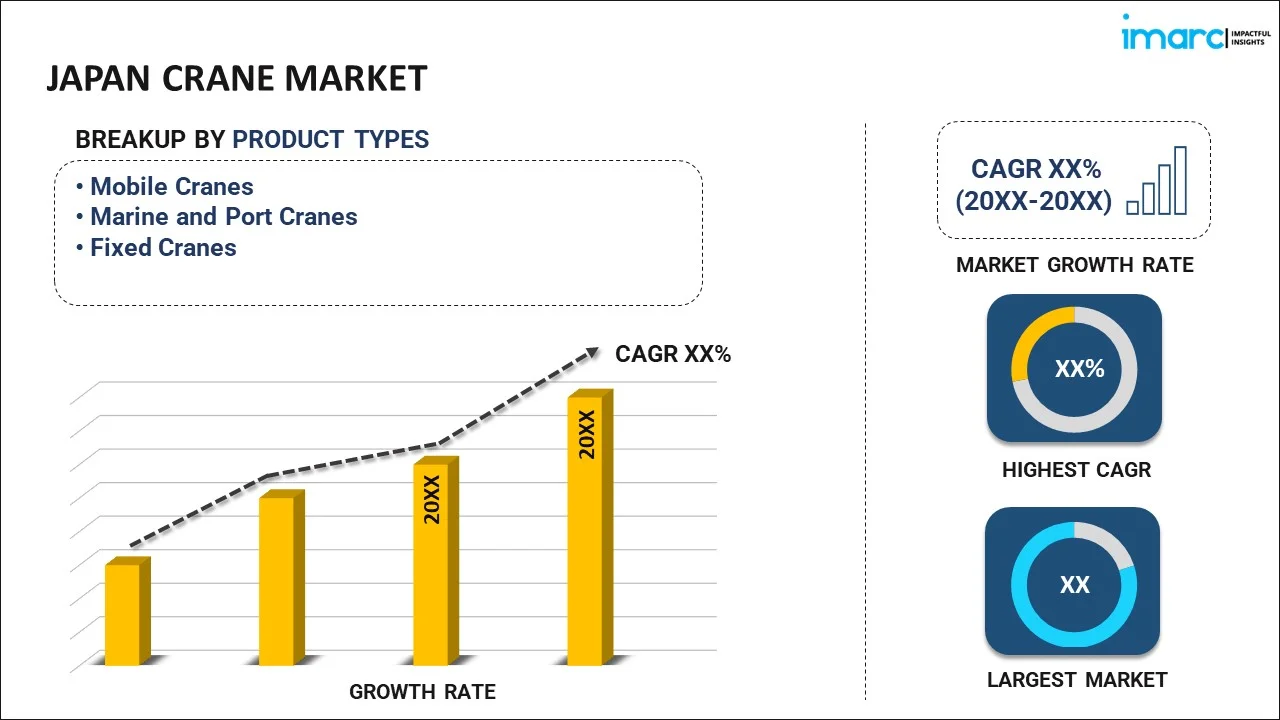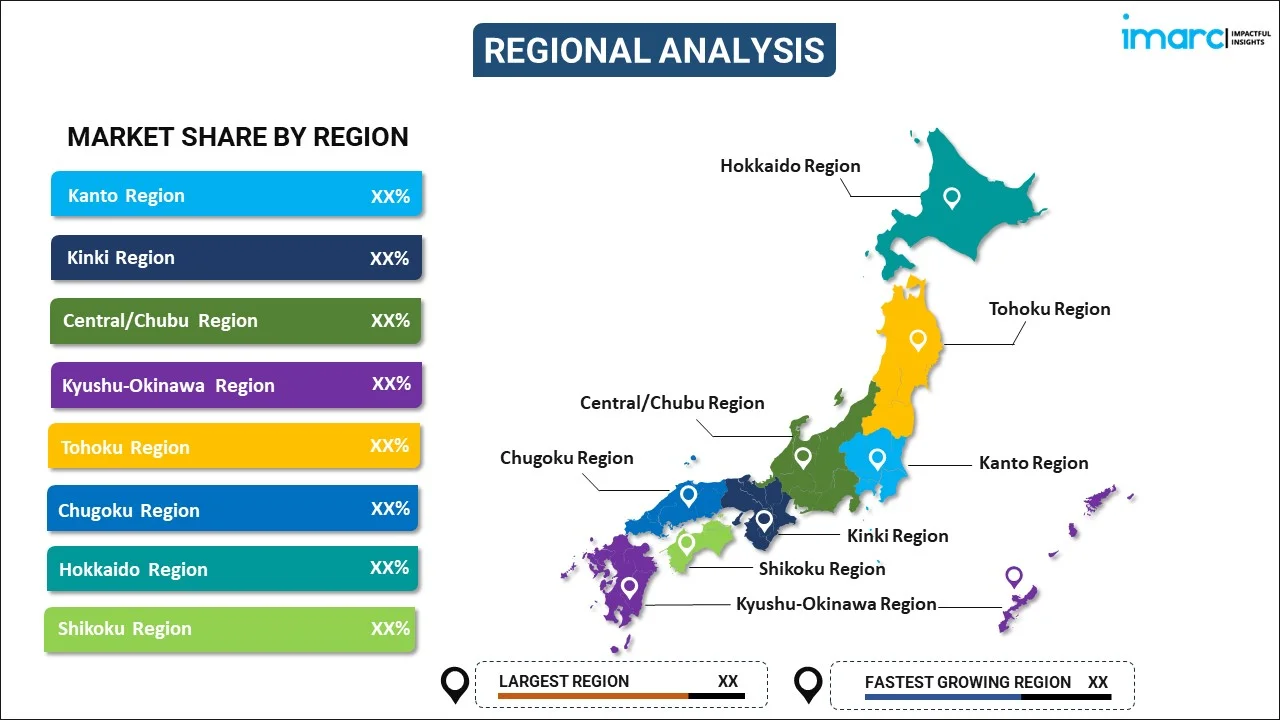
Japan Crane Market Report by Product Type (Mobile Cranes, Marine and Port Cranes, Fixed Cranes), Application (Construction and Infrastructure, Mining, Oil and Gas, and Others), and Region 2025-2033
Market Overview:
The Japan crane market size is projected to exhibit a growth rate (CAGR) of 4.60% during 2025-2033. A resurgence in construction activities, supportive governmental policies and initiatives, technological advancements in crane design, and the rising focus on eco-friendly and energy-efficient crane solutions represent some of the key factors driving the market.
|
Report Attribute
|
Key Statistics
|
|---|---|
|
Base Year
|
2024
|
|
Forecast Years
|
2025-2033
|
|
Historical Years
|
2019-2024
|
| Market Growth Rate 2025-2033 | 4.60% |
A crane is a type of complex machinery equipped with hoists, ropes, and wires that are used to lift, lower, and move heavy objects and materials in various industrial settings. It typically consists of a tower or mast, a boom arm, a hoisting system with ropes or chains, and a hook or other attachment for gripping objects. It is also integrated with sophisticated control systems that govern its precise movements. It is essential in industries such as construction, shipping, manufacturing, and others, where manual handling of large and heavy items would be infeasible, time-consuming, or unsafe. It comes in various forms, including tower, mobile, crawler, and overhead cranes, each designed for specific tasks and applications like erecting skyscrapers, loading heavy containers, and assembling machinery. It plays a vital role in improving operational efficiency, enhancing safety, boosting productivity, and enabling complex tasks that would otherwise be extremely tough or time-consuming. As a result, the crane finds extensive applications in different sectors across the globe, signifying its importance in modern industrial and construction operations.
Japan Crane Market Trends:
The Japan crane market is primarily driven by various factors such as technological advancements, urbanization, and the resurgence in construction activities. The government's commitment to infrastructure development has led to an increase in construction projects across the country, subsequently augmenting the demand for different types of cranes. Moreover, technological innovations in crane design, such as automation and remote-control capabilities, are further contributing to the market growth. These advancements help enhance efficiency and safety while meeting the strict regulatory requirements in Japan, thus attracting more consumers. Additionally, Japan's strategic position in global shipping routes necessitates advanced crane systems in ports, favoring market growth. In line with this, the rising emphasis on sustainability and eco-friendliness is supporting market growth. Manufacturers are focusing on developing cranes with energy-efficient features and lower emissions. This shift toward greener solutions is a response to global environmental concerns, aligning with Japan's stringent regulations regarding energy consumption and environmental protection. Furthermore, extensive investments in research and development (R&D) activities by key players to introduce novel and customized crane solutions catering to diverse industrial needs are propelling market growth. Along with this, the continual surge in demand for modernization and rapid expansion in various industrial sectors across the country underscores the potential for sustained growth in the crane market in the foreseeable future. Other factors, including the integration of Industry 4.0, skilled workforce availability, emerging export opportunities, and flexible financing and leasing options, are also providing a positive thrust to the market growth.
Japan Crane Market Segmentation:
IMARC Group provides an analysis of the key trends in each segment of the Japan crane market report, along with forecasts at the country level for 2025-2033. Our report has categorized the market based on product type and application.
Product Type Insights:

- Mobile Cranes
- Marine and Port Cranes
- Fixed Cranes
The report has provided a detailed breakup and analysis of the market based on the product type. This includes mobile cranes, marine and port cranes, and fixed cranes.
Application Insights:
- Construction and Infrastructure
- Mining
- Oil and Gas
- Others
A detailed breakup and analysis of the market based on the application has also been provided in the report. This includes construction and infrastructure, mining, oil and gas, and others.
Regional Insights:

- Kanto Region
- Kinki Region
- Central/ Chubu Region
- Kyushu-Okinawa Region
- Tohoku Region
- Chugoku Region
- Hokkaido Region
- Shikoku Region
The report has also provided a comprehensive analysis of all the major regional markets, which include Kanto region, Kinki region, Central/ Chubu region, Kyushu-Okinawa region, Tohoku region, Chugoku region, Hokkaido region, and Shikoku region.
Competitive Landscape:
The report has also provided a comprehensive analysis of the competitive landscape in the market. Competitive analysis such as market structure, key player positioning, top winning strategies, competitive dashboard, and company evaluation quadrant has been covered in the report. Also, detailed profiles of all major companies have been provided.
Japan Crane Market Report Coverage:
| Report Features | Details |
|---|---|
| Base Year of the Analysis | 2024 |
| Historical Period | 2019-2024 |
| Forecast Period | 2025-2033 |
| Units | Million USD |
| Scope of the Report | Exploration of Historical and Forecast Trends, Industry Catalysts and Challenges, Segment-Wise Historical and Predictive Market Assessment:
|
| Product Types Covered | Mobile Cranes, Marine and Port Cranes, Fixed Cranes |
| Applications Covered | Construction and Infrastructure, Mining, Oil and Gas, Others |
| Regions Covered | Kanto Region, Kinki Region, Central/ Chubu Region, Kyushu-Okinawa Region, Tohoku Region, Chugoku Region, Hokkaido Region, Shikoku Region |
| Customization Scope | 10% Free Customization |
| Post-Sale Analyst Support | 10-12 Weeks |
| Delivery Format | PDF and Excel through Email (We can also provide the editable version of the report in PPT/Word format on special request) |
Key Questions Answered in This Report:
- How has the Japan crane market performed so far and how will it perform in the coming years?
- What has been the impact of COVID-19 on the Japan crane market?
- What is the breakup of the Japan crane market on the basis of product type?
- What is the breakup of the Japan crane market on the basis of application?
- What are the various stages in the value chain of the Japan crane market?
- What are the key driving factors and challenges in the Japan crane market?
- What is the structure of the Japan crane market and who are the key players?
- What is the degree of competition in the Japan crane market?
Key Benefits for Stakeholders:
- IMARC’s report offers a comprehensive quantitative analysis of various market segments, historical and current market trends, market forecasts, and dynamics of the Japan crane market from 2019-2033.
- The research study provides the latest information on the market drivers, challenges, and opportunities in the Japan crane market.
- Porter's five forces analysis assist stakeholders in assessing the impact of new entrants, competitive rivalry, supplier power, buyer power, and the threat of substitution. It helps stakeholders to analyze the level of competition within the Japan crane industry and its attractiveness.
- Competitive landscape allows stakeholders to understand their competitive environment and provides an insight into the current positions of key players in the market.
Need more help?
- Speak to our experienced analysts for insights on the current market scenarios.
- Include additional segments and countries to customize the report as per your requirement.
- Gain an unparalleled competitive advantage in your domain by understanding how to utilize the report and positively impacting your operations and revenue.
- For further assistance, please connect with our analysts.
 Inquire Before Buying
Inquire Before Buying
 Speak to an Analyst
Speak to an Analyst
 Request Brochure
Request Brochure
 Request Customization
Request Customization




.webp)




.webp)












